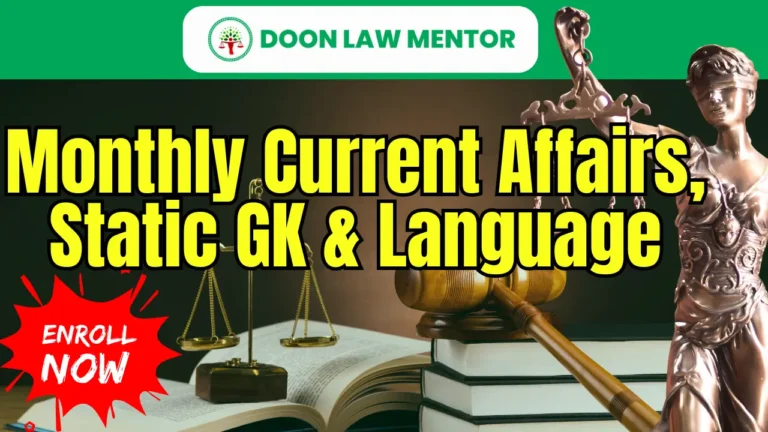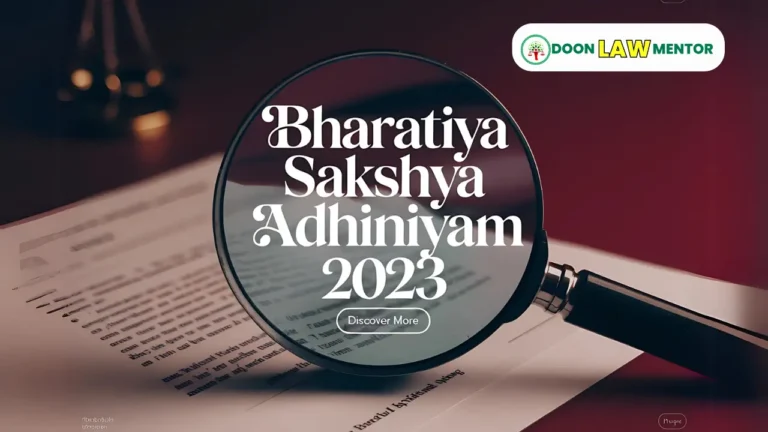Can the words Socialist and Secular be removed from the Indian Constitution? Doon Law Mentor offers a detailed legal analysis for lawyers and law students, exploring the basic structure doctrine, judicial precedents, and constitutional implications of amending the Preamble.
Table of Contents
Introduction
Can the words Socialist and Secular, enshrined in the Preamble of the Indian Constitution, ever be removed, and what legal barriers stand in the way? These terms, introduced by the Constitution (Forty-Second Amendment) Act, 1976, define India’s commitment to economic justice and religious neutrality, sparking debates about their permanence in a dynamic constitutional framework. For lawyers and law students, understanding whether Socialist and Secular can be excised involves grappling with the basic structure doctrine, judicial review, and the limits of parliamentary power under Article 368. This comprehensive legal education article, crafted by Doon Law Mentor, provides an in-depth analysis as of July 9, 2025, exploring the legal, historical, and judicial dimensions of amending the Preamble, offering an authoritative resource for navigating India’s constitutional law.
Historical Context of “Socialist” and “Secular” in the Indian Constitution
Introduction via the 42nd Amendment
The words Socialist and Secular were added to the Preamble through the Constitution (Forty-Second Amendment) Act, 1976, during the Emergency (1975–1977) under Prime Minister Indira Gandhi. The original Preamble, adopted on November 26, 1949, described India as a “Sovereign Democratic Republic.” The 42nd Amendment expanded this to “Sovereign Socialist Secular Democratic Republic,” reflecting the government’s intent to emphasize economic equality and religious neutrality.
- Socialist: Signifies a commitment to social and economic justice, promoting equitable distribution of resources and reducing inequalities, as reflected in Directive Principles of State Policy (DPSPs) like Articles 38 and 39. It does not denote Marxist socialism but a democratic socialism aligned with India’s mixed economy.
- Secular: Affirms the state’s neutrality in religious matters, ensuring equal treatment of all religions without endorsing or discriminating against any, as embodied in Articles 25–28 (Fundamental Rights to freedom of religion).
Rationale for Inclusion
The 42nd Amendment’s inclusion of Socialist and Secular aimed to codify principles already implicit in the Constitution:
- Socialism: Reflected in DPSPs (e.g., Article 39(b)–(c) on resource distribution) and policies like land reforms and nationalization of industries.
- Secularism: Embedded in Articles 14 (equality), 15 (non-discrimination), and 25–28, ensuring religious freedom and state impartiality.
The amendment responded to socio-political demands for clarity on India’s ideological stance, particularly during the Emergency’s contentious period.
Constitutional Provisions Involved
- Preamble: Declares India’s objectives, including Socialist and Secular, guiding constitutional interpretation.
- Article 368: Empowers Parliament to amend the Constitution, including the Preamble, subject to procedural and substantive limits.
- Article 14: Guarantees equality, reinforcing secularism by prohibiting religious discrimination.
- Articles 25–28: Protect religious freedom, underpinning secularism.
- Articles 38–39: Promote social and economic justice, supporting socialism.
- Basic Structure Doctrine: Limits Parliament’s amendment power to protect core constitutional features.
Legal Issues: Can “Socialist” and “Secular” Be Removed?
The question of removing Socialist and Secular from the Preamble raises several legal issues:
- Preamble’s Amendability: Can the Preamble be amended to remove Socialist and Secular, given its role as a guiding principle?
- Basic Structure Doctrine: Are Socialist and Secular part of the Constitution’s basic structure, rendering them unamendable?
- Parliament’s Power under Article 368: Does Parliament have the authority to delete Socialist and Secular, or are there substantive limits?
- Judicial Review: Can courts strike down such an amendment if it violates fundamental constitutional principles?
- Impact on Fundamental Rights: Would removing Socialist and Secular undermine rights like equality (Article 14) or religious freedom (Article 25)?
Read More: One Big Beautiful Bill: Key Provisions and Legal Implications for 2025
Legal Framework and Judicial Precedents
1. Basic Structure Doctrine
The basic structure doctrine, established in Kesavananda Bharati v. State of Kerala (1973), is central to analyzing whether Socialist and Secular can be removed. The doctrine holds that Parliament’s power to amend the Constitution under Article 368 is not absolute; amendments cannot alter the Constitution’s basic structure—core features like democracy, secularism, judicial review, and equality.
- Secularism as Basic Structure: The Supreme Court in S.R. Bommai v. Union of India (1994) explicitly held that secularism is a basic structure feature, integral to India’s constitutional identity. Secularism ensures state neutrality, protecting religious freedom (Articles 25–28) and equality (Article 14).
- Socialism as Basic Structure: While not explicitly declared, socialism’s principles are embedded in the basic structure through economic justice (Articles 38–39) and equality (Article 14). In Minerva Mills v. Union of India (1980), the Court emphasized the balance between Fundamental Rights and DPSPs, suggesting socialism’s core role.
Removing Socialist and Secular would likely violate the basic structure, as they underpin India’s constitutional ethos.
2. Amendability of the Preamble
In Kesavananda Bharati (1973), the Supreme Court clarified that the Preamble is part of the Constitution and amendable under Article 368, provided the amendment does not violate the basic structure. The 42nd Amendment’s addition of Socialist and Secular was upheld, as it reinforced existing constitutional principles. However, deleting these terms could disrupt the Preamble’s coherence and the Constitution’s foundational objectives, inviting judicial scrutiny.
3. Judicial Review of Amendments
The Supreme Court’s power to review constitutional amendments, affirmed in I.R. Coelho v. State of Tamil Nadu (2007), ensures that amendments violating the basic structure are struck down. An amendment removing Socialist and Secular would face rigorous judicial review, particularly for undermining secularism’s explicit basic structure status and socialism’s implicit role.
Read More: Kesavananda Bharati Case: Legal Analysis of the Basic Structure Doctrine
4. Key Judicial Precedents
- Kesavananda Bharati v. State of Kerala (1973)*: Established the basic structure doctrine, limiting Parliament’s amendment power.
- S.R. Bommai v. Union of India (1994)*: Declared secularism a basic structure feature, emphasizing its role in federalism and religious freedom.
- Minerva Mills v. Union of India (1980)*: Struck down parts of the 42nd Amendment for disrupting the balance between Fundamental Rights and DPSPs, implying socialism’s constitutional significance.
- Indra Sawhney v. Union of India (1992)*: Upheld affirmative action under Article 16, reinforcing socialism’s commitment to social justice.
- R.C. Poudyal v. Union of India (1993)*: Reaffirmed secularism’s basic structure status, linking it to equality and non-discrimination.
These precedents suggest that removing Socialist and Secular would be unconstitutional if it alters the Constitution’s core identity.
Comprehensive Legal Analysis
Can “Secular” Be Removed?
Secularism, as a basic structure feature, is deeply entrenched in the Indian Constitution. Its removal would:
- Undermine Fundamental Rights: Articles 14 (equality), 15 (non-discrimination), and 25–28 (religious freedom) rely on secularism to ensure state neutrality. Deleting Socialist and Secular could weaken these protections, enabling discriminatory laws.
- Disrupt Federalism: In S.R. Bommai (1994), the Court linked secularism to federalism, noting that religious discord threatens national unity. Removing “Secular” could destabilize India’s diverse federal structure.
- Violate Basic Structure: As explicitly declared in S.R. Bommai and R.C. Poudyal, secularism’s removal would be struck down as unconstitutional.
Legal Barrier: The judiciary’s consistent affirmation of secularism as a basic structure feature makes its removal highly improbable. Any amendment deleting “Secular” would fail judicial review under I.R. Coelho (2007).
Can “Socialist” Be Removed?
Socialism, while not explicitly declared a basic structure feature, is integral to the Constitution’s commitment to social and economic justice. Its removal would:
- Weaken DPSPs: Articles 38 and 39, which mandate reducing inequalities and equitable resource distribution, reflect socialist principles. Deleting Socialist and Secular could dilute these obligations.
- Impact Equality: Socialism supports affirmative action (e.g., reservations under Article 16), as upheld in Indra Sawhney (1992). Removing “Socialist” might undermine such measures.
- Alter Constitutional Balance: Minerva Mills (1980) emphasized the harmony between Fundamental Rights and DPSPs, suggesting socialism’s core role. Its deletion could disrupt this balance.
Legal Barrier: Although socialism’s basic structure status is implicit, its removal would likely violate related basic structure features like equality and justice, inviting judicial intervention.
Parliamentary Power under Article 368
Article 368 grants Parliament the power to amend any part of the Constitution, including the Preamble, with a two-thirds majority in both Houses and, in some cases, state ratification. However, Kesavananda Bharati (1973) imposed substantive limits, preventing amendments that destroy the Constitution’s basic structure. An amendment removing Socialist and Secular would require:
- Procedural Compliance: A special majority and, potentially, ratification by half the states if it affects federal provisions (e.g., secularism’s role in federalism).
- Substantive Validity: The amendment must not violate the basic structure, a threshold unlikely to be met given secularism’s explicit and socialism’s implicit status.
Judicial Review and Potential Outcomes
If Parliament attempts to remove Socialist and Secular, the Supreme Court would review the amendment under I.R. Coelho (2007). Possible outcomes include:
- Striking Down the Amendment: If the Court finds that deleting Socialist and Secular violates secularism, equality, or justice, the amendment would be declared unconstitutional.
- Partial Upholding: If the amendment redefines (not removes) these terms without altering the basic structure, it might be upheld, though this is speculative.
- Political Consequences: Even if legally permissible, such an amendment would face significant political and social resistance, given India’s diverse populace.
Case Studies
Case Study 1: S.R. Bommai v. Union of India (1994)
- Context: The dismissal of state governments under Article 356 was challenged, with secularism’s role in federalism at issue.
- Judicial Outcome: The Supreme Court declared secularism a basic structure feature, linking it to equality, religious freedom, and national unity. The Court held that state actions promoting religious discord violate the Constitution.
- Implications: Reinforces that removing “Secular” from the Preamble would be unconstitutional, as it is integral to the basic structure.
Case Study 2: Minerva Mills v. Union of India (1980)
- Context: Parts of the 42nd Amendment, prioritizing DPSPs over Fundamental Rights, were challenged.
- Judicial Outcome: The Court struck down provisions disrupting the balance between Fundamental Rights and DPSPs, emphasizing economic justice (socialism) as a constitutional pillar.
- Implications: Suggests that removing “Socialist” could violate the basic structure by undermining justice and equality.
Case Study 3: Kesavananda Bharati v. State of Kerala (1973)
- Context: The 24th, 25th, and 29th Amendments were challenged, leading to the basic structure doctrine.
- Judicial Outcome: The Court held that amendments cannot destroy the Constitution’s core features, including democracy and equality, which underpin Socialist and Secular.
- Implications: Establishes the legal framework preventing the removal of Socialist and Secular if it alters the basic structure.
Comparative Analysis: Constitutional Amendments Globally
United States
- Framework: The U.S. Constitution’s amendment process (Article V) requires a two-thirds majority in Congress and ratification by three-fourths of states, with no explicit “basic structure” limit.
- Comparison: Unlike India, the U.S. lacks a judicially enforceable limit on amendments, though implied limits exist (e.g., federalism). Removing terms like “Socialist and Secular” would face political, not legal, barriers.
- Relevance: India’s basic structure doctrine provides stronger judicial protection against fundamental changes.
Germany
- Framework: Article 79(3) of the German Basic Law prohibits amendments affecting human dignity, democracy, or federalism, akin to India’s basic structure.
- Comparison: Germany’s “eternity clause” parallels India’s protection of secularism, suggesting Socialist and Secular are similarly entrenched.
- Relevance: Reinforces the global trend of protecting core constitutional principles.
South Africa
- Framework: The South African Constitution allows amendments but subjects them to judicial review for consistency with founding values like equality and human rights.
- Comparison: Like India, South Africa’s judiciary can strike down amendments violating core principles, supporting the unamendability of Socialist and Secular.
- Relevance: Highlights judicial oversight as a universal safeguard.
Implications for Lawyers and Law Students
The question of removing Socialist and Secular offers significant learning opportunities:
- Constitutional Law: Understanding the basic structure doctrine and Article 368 is critical for analyzing amendment challenges.
- Judicial Review: Lawyers must grasp the judiciary’s role in reviewing amendments, as per I.R. Coelho (2007).
- Fundamental Rights: The interplay between Socialist and Secular and rights like equality (Article 14) and religious freedom (Article 25) is essential for litigation.
- Public Interest Litigation: PILs challenging amendments removing Socialist and Secular could arise, requiring expertise in constitutional law.
- Policy Advocacy: Lawyers may advise on constitutional amendments, ensuring compliance with the basic structure.
- Comparative Constitutional Law: Global perspectives enhance expertise in protecting core constitutional principles.
Table: Key Constitutional Provisions and Principles
| Provision/Principle | Description | Role in Protecting Socialist and Secular |
|---|---|---|
| Preamble | Declares India’s objectives | Enshrines Socialist and Secular as guiding principles |
| Article 368 | Empowers constitutional amendments | Limited by basic structure doctrine |
| Article 14 | Equality before the law | Supports secularism and socialism |
| Articles 25–28 | Religious freedom | Reinforce secularism |
| Articles 38–39 | Social and economic justice | Underpin socialism |
| Basic Structure Doctrine | Protects core constitutional features | Prevents removal of Socialist and Secular |
This table, created by Doon Law Mentor, summarizes the constitutional framework protecting Socialist and Secular.
Critical Evaluation
The words Socialist and Secular are deeply entrenched in the Indian Constitution, protected by the basic structure doctrine. Secularism’s explicit status as a basic structure feature, affirmed in S.R. Bommai (1994), makes its removal constitutionally impermissible. Socialism, while implicitly protected, supports economic justice and equality, suggesting its deletion would also violate the basic structure. However, the lack of explicit judicial declaration on socialism’s status leaves some ambiguity, requiring case-by-case judicial interpretation. Political attempts to remove Socialist and Secular would face legal, social, and political resistance, given India’s diverse and egalitarian ethos. For lawyers and law students, this issue underscores the judiciary’s role as the Constitution’s guardian, offering a rich field for constitutional scholarship and litigation.
Conclusion: The Unamendable Core of the Constitution
The words Socialist and Secular in the Indian Constitution’s Preamble are unlikely to be removed due to the basic structure doctrine, which safeguards core features like secularism and economic justice. Judicial precedents, such as Kesavananda Bharati (1973) and S.R. Bommai (1994), reinforce their permanence, ensuring that amendments under Article 368 do not undermine India’s constitutional identity. For legal professionals, understanding this framework is crucial for constitutional litigation and policy advocacy. Join Doon Law Mentor at doonlawmentor.com to explore this critical constitutional issue and advance your expertise in Indian constitutional law.
FAQs
Can the words Socialist and Secular be removed from the Constitution?
Removing Socialist and Secular is unlikely, as they are protected by the basic structure doctrine, particularly secularism.
Why were Socialist and Secular added to the Preamble?
Socialist and Secular were added via the 42nd Amendment (1976) to emphasize economic justice and religious neutrality.
Is secularism part of the basic structure?
Yes, secularism is a basic structure feature, as held in S.R. Bommai v. Union of India (1994).
What limits Parliament’s amendment power?
The basic structure doctrine, established in Kesavananda Bharati (1973), prevents amendments destroying core constitutional features.
How can lawyers use this issue?
Lawyers can litigate or advise on challenges to amendments affecting Socialist and Secular, leveraging the basic structure doctrine.
#SocialistAndSecular #IndianConstitution #BasicStructureDoctrine #DoonLawMentor







